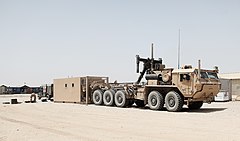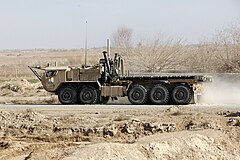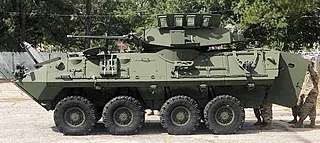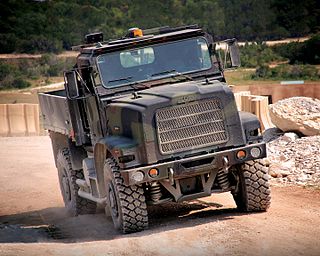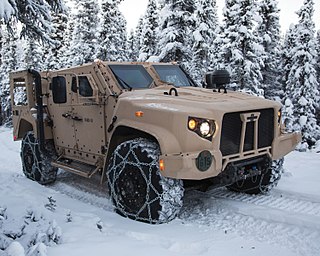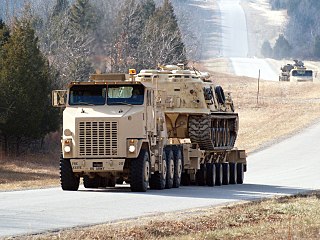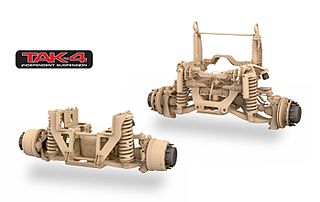| Oshkosh Logistic Vehicle System Replacement (LVSR) | |
|---|---|
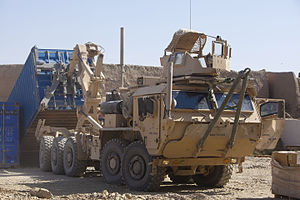 U.S. Marine's Oshkosh Logistic Vehicle System Replacement (LVSR) | |
| Type | 10x10 tactical trucks with up to 16.5 / 22.5 ton off-road / on-road payload (MKR18 cargo) |
| Place of origin | United States of America |
| Service history | |
| In service | 2009–present (first fielding 2009) |
| Used by | U.S. Marines |
| Production history | |
| Designer | Oshkosh [1] |
| Designed | March 2004 (LVSR Phase I System Development and Demonstration Contract award) |
| Manufacturer | Oshkosh Corporation [1] |
| Produced | 2005-2013 (remains available) |
| No. built | 2020 |
| Variants | MKR15 – wrecker (160) MKR16 – tractor (355) MKR18 – cargo (1505) |
| Specifications | |
| Mass | 24,517 kilograms (54,051 lb) unladen, 44,929 kilograms (99,051 lb) laden (A-kit configuration; B-kit adds approx. 2,041 kilograms (4,500 lb)). Towed load 24,040 kilograms (53,000 lb) kg |
| Length | 10.98 metres (432 in) |
| Width | 2.490 metres (98.0 in) |
| Height | 4.11 metres (162 in) (with ISO container) |
| Crew | 2 (third space for optional gunner position) [1] |
| Armor | a-kit/b-kit; U.S. Army Long Term Armor Strategy (LTAS) compliant |
| Engine | Caterpillar (CAT) C-15 15.2-liter, inline-six water-cooled diesel developing 600 hp [2] @ 1800 rpm and 2508 Nm torque at 1200 rpm |
| Payload capacity | 16.5 ton: 33,000 lb (14,969 kg) off-road — 22.5 ton: 45,000 lb (20,412 kg) on-road |
| Transmission | Allison 4700SP 7-speed automatic and Oshkosh 35000 single-speed transfer case |
| Suspension | Oshkosh TAK-4 independent. [3] Front axles rated at 7,666 kg; rear axles rated at 10,478 kg |
| Fuel capacity | 628 litres |
Operational range | 483 kilometres (300 mi) [1] |
| Speed | 105 kilometres per hour (65 mph) [2] |
Steering system | Power-assisted, 1st, 2nd, 4th and 5th axles (mechanically controlled 4th and 5th axle contra-steer) [1] |
The Logistic Vehicle System Replacement (LVSR) is a family of vehicles, based on a common 5-axle ten-wheel drive (10x10) chassis, that vary in individual configuration by mission requirements. The LVSR was designed and is manufactured by Oshkosh Defense. [2] LVSR is a purpose-designed military vehicle and there are currently three variants in service, a cargo, a wrecker and a tractor truck. [2]

Ten-wheel drive, 10WD or 10×10 is a drivetrain configuration of ten wheels, all of which are driven simultaneously by the engine. Unlike four-wheel drive drivetrains, this configuration is only used in extreme off-road and military uses, in particular heavy duty uses, such a heavy haulage and missile carriers. It is also used in lorries.

Oshkosh Corporation, formerly Oshkosh Truck, is an American industrial company that designs and builds specialty trucks, military vehicles, truck bodies, airport fire apparatus and access equipment. The corporation also owns Pierce Manufacturing, a fire apparatus manufacturer in Appleton, Wisconsin. Based in Oshkosh, Wisconsin, the company employs approximately 16,000 people around the world. It is organized in four primary business groups: access equipment, defense, fire and emergency, and commercial.

A tow truck is a truck used to move disabled, improperly parked, impounded, or otherwise indisposed motor vehicles. This may involve recovering a vehicle damaged in an accident, returning one to a drivable surface in a mishap or inclement weather, or towing or transporting one via flatbed to a repair shop or other location.
Contents
- Development and production history
- Technical description
- Armor protection kit
- Gallery
- Variants
- Operators
- See also
- References
- External links
The first LVSRs were ordered in 2006. The LVSR is the U.S. Marines’ equivalent of the U.S. Army’s Oshkosh Heavy Expanded Mobility Tactical Truck (HEMTT) and Oshkosh Palletized Load System (PLS). The Marines do not use the HEMTT or PLS [4] and the Army does not use the LVSR, but both services use a common trailer (M1076) with all three truck types.

The United States Marine Corps (USMC), also referred to as the United States Marines, is a branch of the United States Armed Forces responsible for conducting expeditionary and amphibious operations with the United States Navy as well as the Army and Air Force. The U.S. Marine Corps is one of the seven uniformed services of the United States.

The United States Army (USA) is the land warfare service branch of the United States Armed Forces. It is one of the seven uniformed services of the United States, and is designated as the Army of the United States in the United States Constitution. As the oldest and most senior branch of the U.S. military in order of precedence, the modern U.S. Army has its roots in the Continental Army, which was formed to fight the American Revolutionary War (1775–1783)—before the United States of America was established as a country. After the Revolutionary War, the Congress of the Confederation created the United States Army on 3 June 1784 to replace the disbanded Continental Army. The United States Army considers itself descended from the Continental Army, and dates its institutional inception from the origin of that armed force in 1775.

The Heavy Expanded Mobility Tactical Truck (HEMTT) is an eight-wheel drive, diesel-powered, 10-short-ton (9,100 kg), tactical truck used by the US military and others. In evolving configurations, it has been in continuous production since 1982. The M977 HEMTT entered service with the U.S. Army as a replacement for the M520 Goer.




